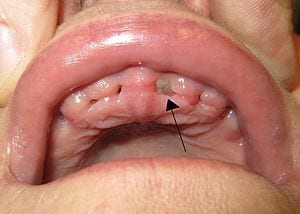Contents
General description of the disease
Alveolitis of the tooth socket is an inflammatory process of the socket wall, which begins after tooth extraction, and not only the alveolus (tooth socket), but also the gums can be affected.
Read also our dedicated article on nutrition for dental and gum health.
Alveolitis reasons:
- 1 the tooth was removed in the wrong way;
- 2 in the hole of the tooth, after getting rid of it, a particle of its root remained or the damaged tissue was not completely removed;
- 3 after a serious operation on the tooth (it is called traumatic);
- 4 the patient did not follow the rules of dental hygiene and did not follow the recommendations of the dentist;
- 5 smoking (tar, impurities and nicotine contained in cigarettes have a bad effect on the wound healing process);
- 6 reduced immunity.
The main signs of tooth alveolitis:
- severe, burning pain at the site of tooth extraction;
- there is no blood clot that protects against infections (this is the natural protection of the tooth socket from possible ingress of bacteria and infections for a while while the wound healing process is in progress);
- there is a gray coating at the site of the wound;
- pus is released from the alveoli;
- red, swollen gums near the alveoli where the tooth was pulled out;
- smells bad from the mouth;
- lymph nodes under the neck and jaw are enlarged;
- when eating, painful, unpleasant sensations that make it difficult;
- the patient has increased fatigue, poor health.
Useful products for alveolitis of the tooth socket
During the healing of the wound that arose during tooth extraction, you should take care of your teeth and eat more fermented milk products (milk, yoghurts, sour cream, cream, cottage cheese, processed cheese, kefir, yogurt) and dishes made from them (milk cereals, soufflé, jelly, jelly).
Also, emphasis should be placed on replenishing vitamins in the body (high immunity will cope with all possible viruses). To do this, you need to eat more fruits, berries, vegetables.
But, in order not to damage the blood clot, which serves as protection from bacteria, hard fruits and food must be crushed or eaten in the form of mashed potatoes and mousses.
Broths, various cereals (oatmeal, wheat, rice, millet and other finely ground foods that suit the patient’s taste) will be good food.
All dishes are best steamed or boiled. Food prepared in this way will be easy to chew and will not injure a healing wound.
Traditional medicine for alveolitis of the tooth socket
The main treatment of traditional medicine is rinsing the mouth with various infusions that have soothing, antibacterial, healing properties.
These include infusions made from:
- 1 ротокана;
- 2 calendula (its flowers);
- 3 pharmacy chamomile;
- 4 swamp calamus root;
- 5 medicinal sage.
Prepared broths need to be rinsed in the first days – every 30-40 minutes, in subsequent – gradually increase the distance between procedures up to an hour and a half.
In addition to rinsing, lotions can be made from these infusions and decoctions. To do this, you need to prepare small gauze swabs by dipping them into the broth and attaching them to the sore spot.
In addition to real dried herbs, you can use tinctures of sage, chamomile, rotocan, calendula and other antiseptics purchased at the pharmacy. All of them are alcohol-based, so before use they should be diluted with warm boiled water so as not to burn the delicate mouth cavity.
Mixtures are also an effective and fast-acting healing agent. Here is an example of one of them: take the seeds of the blessed knikus and flax, the flowers of blue cornflowers, oregano, sunflower petals, the grass of a creeping tenacious. The shelf life of these plants should not exceed one year. All the components of the mixture must be taken in the same proportions, finely chopped and pounded, the seeds must be mixed. For 30 grams of such a mixture, 250 milliliters of water will be required (always hot and only boiled). Pour herbs over it and leave to infuse for an hour (at least). Then filter. Drink 2/3 cup four times a day.
Also, good for rinsing:
- brine;
- a solution made from baking soda (1/2 teaspoon is needed for 200 milliliters of warm water);
- 5% hydrogen peroxide diluted with warm boiled water;
- you can chop up dental paste or tooth powder and gargle with this solution.
Dangerous and harmful products for alveolitis of the tooth socket
In order for the wound to heal faster, it is necessary to abandon for a while (about a week):
- fried dishes to the crust;
- hard vegetables and fruits, as well, from products containing small bones (they can fall into the hole and damage the protective layer of the clot);
- salty and sour foods (marinades, spices, vinegar, horseradish, mustard) – they will corrode the wound;
- sweet (chocolate with cream will fall into the hole, which is extremely bad, a purulent process may begin);
- smoking;
- wholemeal bread, bran and whole grain bread;
- cereals, whole grains;
- nuts, seeds, flax seeds, sesame seeds, pumpkin and so on.
Attention!
The administration is not responsible for any attempt to use the information provided, and does not guarantee that it will not harm you personally. The materials cannot be used to prescribe treatment and make a diagnosis. Always consult your specialist doctor!










